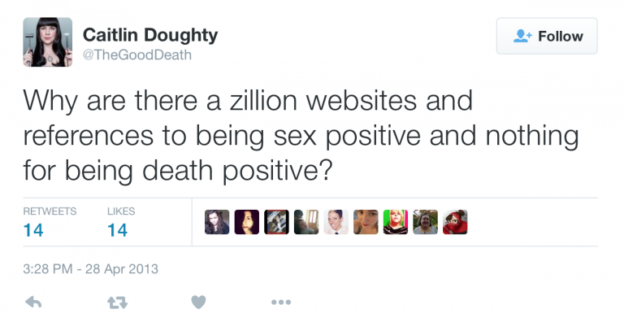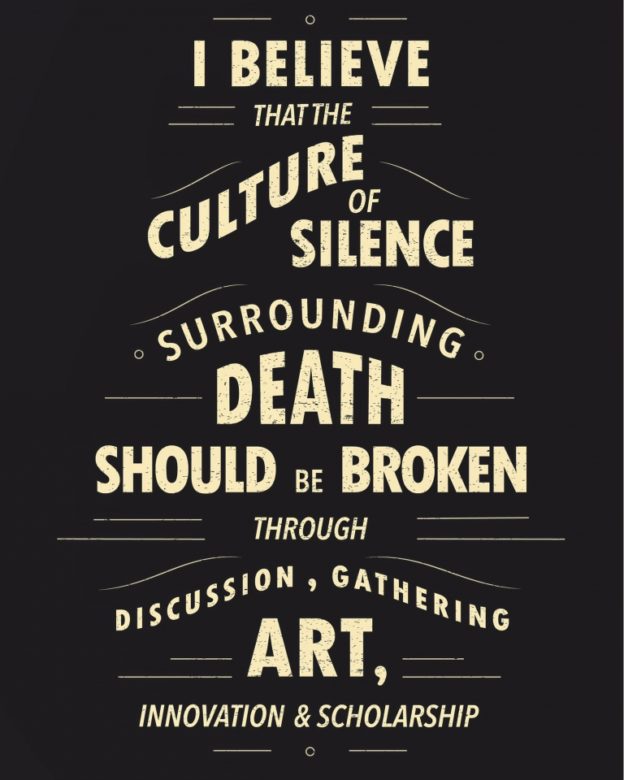What Is The “Death Positive Movement” And What Does It Mean For The Funeral Profession?
May 29th, 2019
If you scroll through any major media website today, you won’t be hard pressed to find the words “death” and “positive” together.
Put those words together, and you have yourself a death positive movement.
This movement is sweeping its way through the funeral profession. And unlike other movements that have begun here, this movement is being embraced in other industries, too.
The New York Times, Fast Company and even Marie Claire Magazine are writing about the death positive movement. People are tweeting about it like crazy. Art is being created around it.
Dying as one wishes has become a luxury.
Even though 70% of people would prefer to die at home surrounded by loved ones, most forfeit their future to a windowless hospital room, attached to tubes and monitors.
Behold the “death positive movement.” https://t.co/Zb8aj1SNnG— Fast Co. Ideas (@FastCoIdeas) May 7, 2019
In short, it’s a movement not to be ignored. In fact, this movement could be just the movement the funeral profession needs to re-position itself as the thought leaders and support system we ought to be.
You ready for it? Before you dive in heart first, let’s take a look at what it is, and how it started.
When did the death positive movement start?
We suspect the catalyst of the death positive movement was this tweet by Caitlin Doughty, Founder of Order Of The Good Death, nearly 6 years ago:

Doughty, in a later article, explained the Death Positive Movement with this quote:
“Death positivity is saying, “I am fascinated by death, the history of death, how cultures around the world handle death, my own relationship to mortality, and I refuse to be ashamed of that interest.”
While the movement is a very helpful one for humanity, there are still many myths about death positivity (like that it was started by a bunch of gothic folks), that Doughty has been working to dispel, slowly.
As funeral professionals, I feel it’s our duty to be of service in the death positive movement.
Feeling called? Here’s how you can get involved with the death positive movement at your funeral home, explained by some industry leaders:
1. Re-imagine the funerals you create
“Everything around dying is getting radically rethought–from making the experience more humane to mourning and funerals getting reimagined.”
– Global Wellness Institute 2019 wellness trends report
How to do it: Check out how some of your peers are already re-imagining their services, see what works, and try it yourself.
2. Embrace the humanity behind your services
“Dying is a human experience. We’re trying to put the person back into the center of the experience.”
– Ellen Goodman of the Conversation Project
How to do it: Try out the “EXTRA” model, which encourages conversations that are more about the story and the memories, rather than logistics and pricing.
3. Invite non-religious rituals into your practice
“We just don’t know what to do with death anymore… it’s this big, scary thing. We don’t have a set of rituals around it that contains it or gives it meaning. Ours is the first culture to pathologize an interest in death.”
– Joanna Ebenstein, author of Morbid Anatomy
How to do it: Try working with non-religious families and see what kinds of rituals they enjoy most, and try to embrace the non-religious approach to funerals, rather than letting confusion set in.
4. Host a Death Cafe
“We’re not supposed to be curious about death now… but how can you not be? It’s a great human mystery. It’s the thing that defines our life, but we’re supposed to pretend it’s not interesting to us? [The Death Cafe] is almost like my form of activism to create an atmosphere publicly that permits talking about death. If we can talk about death and dying, maybe that will spread to easier conversations about grief and terminal illness.”
– Millet Israeli, host of Death Cafes
How to do it: Partner with local organizations and cafes to start your own grassroots Death Cafe. See how others are doing it here.
5. Tap into the power of Death Doulas
“We got so far removed from death even being an option that we finally got sick of it being closeted”
– Suzanne O’Brien, host of podcast “Ask a Death Doula”
How to do it: You can either hire a Death Doula to work with you at your funeral home, or you can do a Death Doula training yourself. Read all about Death Doulas here and here.
6. Encourage important conversations before pre-planning
“Remembering that I’ll be dead soon is the most important tool I’ve ever encountered to help me make the big choices in life.”
– Steve Jobs, founder of Apple
How to do it: Although many people are showing interest in pre-planning, not many are actually doing it. What processes do you have in place that are encouraging for families to pre-plan? What processes or programs are others using that are successful? Do your research and adapt your process as often as necessary. Testing is the way to success!
7. Embrace the feminine aspects of listening and empathy
“We’re part of a movement, and it’s really a return to a female presence at the time of death,” Ms. Cunningham said.
– Amy Cunningham, Greenwood Heights Funeral & Cremation Services,
How to do it: We recently posted an article called “The Funeral Director Job Description of the Future” in which we discussed the vital skills of empathy and listening. Check it out, and if you want to hone in on your listening skills, check out this slide deck below:
Final words
The death positive movement is possibly the biggest catalyst in our profession other than death itself. It’s a HUGE opportunity for the funeral profession to adapt and make things right with client families once and for all. An opportunity to learn about ourselves, and our families. A calling to collaborate. To come together. To remember the traditions we came from, and combine their beauty with relevance.
And our final words for you are to… embrace it.
What do you think about the death positive movement? How would you like to take part in it? Tell us in the comments below!



Your hyperlink says that Doughty founded “The Good Death”, which is actually called “The Order of the Good Death”, an important distinction only because it illustrates what the order actually is-a network of funeral professionals, writers, artists, medical and hospice workers, academics etc. who are all Order members working toward the same goals for the industry…inviting conversation, encouraging family participation, promoting ecological options and fighting fear and stigma through community connection.
Thank you for putting a spotlight on the Death positive movement!
Sincerely,
Funeral Counselor
Eight years (and counting) member of Order of the Good Death
Hi there Rachel, thank you for that comment, and for the correction! It’s made in the blog now, thanks for your service to this movement! – Krystal
I am so relieved & happy to find that I’m not alone in my attitude toward death. I had become a Registered Nurse in mid-life and at graduation, they ask you in what areas do you want to work? I told them – Nursery and Hospice. I’ve been a nurse for 30+ years now & fortunately, gratefully, I was blessed to have my wish. I think working as a Hospice Nurse was such a gift in my 40’s because those patients taught me so much. Ever since, I have talked openly & comfortably about death, including my own, and mostly, people FREAK OUT. I lost my first son when he was 3 months old. They basically sent me home with him without ANY support except “Call us if you have any questions “. That was 1972, and the driving force behind my desire to become a Hospice Nurse. In 1997, my oldest son committed suicide. Again, I was in “free fall” but at least there was a lot more information, ie: support group/books, available by then. I’ve taught Childbirth Classes and loved every minute of it. I have served women, many friends or acquaintances, as a Doula. I wish I weren’t so exhausted now or I’d take a course in how to become a Death Doula!
Wow Nancy, what a beautiful story! We’re really touched by it. We’d love to have you tell us more about your story! Would you be open to doing an interview with us on your attitude towards death? We love it! Thanks.
[…] the death positive movement grows, so does the need for spaces to gather and share ideas. With over 66 countries participating […]
[…] does what it says on the tin. In simple terms, it’s an individual’s fascination of death, the interest in its history and how different cultures around the world celebrate it. The movement is based on […]
[…] we know you must have caught wind of the Death Positive movement, the Death Cafe momentum, and the rise of the Death Doula and Soul […]
[…] fact, psychedelics are some of the most death positive substances we know […]